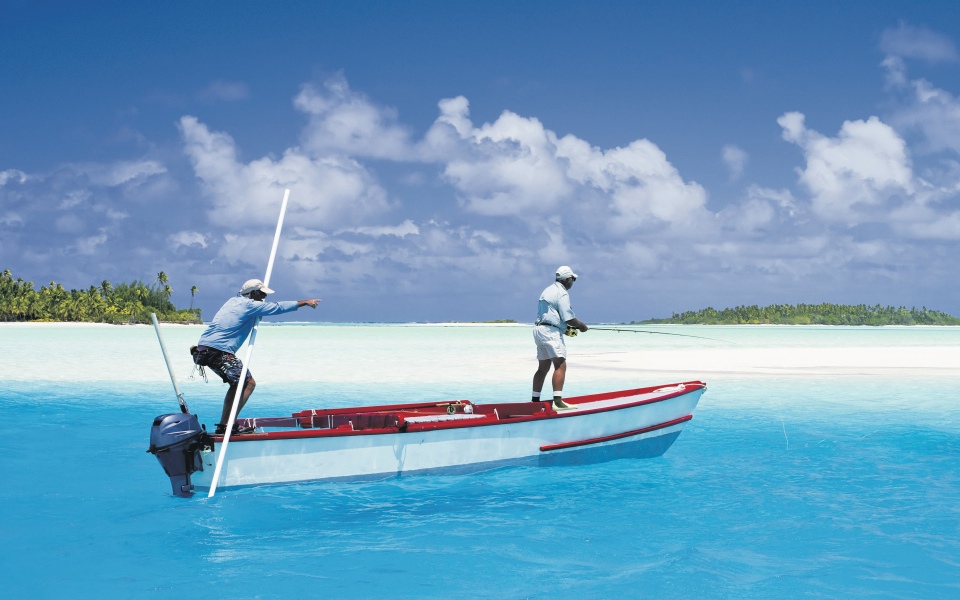Want to get the most out of the Cook Islands? Follow Chris Osburn as he explores this South Pacific paradise…

The Cook Islands is a nation comprising 15 small islands sprinkled across a patch of the South Pacific, roughly halfway between Hawaii and New Zealand. As remote as they are spectacular, the collection of islands is reminiscent of Hawaii before its mid-century tourism-boom, and though the largest of its islands is today ringed by boutique hotels, much of the country is untouched and feels wildly tropical.
I spent a week discovering this idyllic Polynesian archipelago back in early autumn, splitting my time across two islands: Rarotonga, the largest, and the tiny atoll of Aitutaki.
Rarotonga
The hub of the Cook Islands, and by far the most populous of them, Rarotonga proves an excellent base from which to explore the rest of the islands. Much of my time there was spent lounging around an airy beachside bungalow at Little Polynesian, a luxury resort situated on a secluded stretch of the island’s southeastern coast, with rooms looking out over the expansive ocean. This means one extraordinary thing; whale watching from bed. It really is something to awake to the spectacle of humpback whales breaching just beyond the reef.
If you can tear yourself away from this magnificent sight, go for a quick poolside breakfast, then catch a Sunday service at Titikaveka church across the road from the resort. Tourists are encouraged to visit this church, and others across the island, offering them a chance to hear beautiful hymns sung acapella in the native Maori language.
Later in the week I cycled around Rarotonga with Storytellers, a tour group that teaches the history and culture of the Cook Islands as you wind along rolling dirt paths on high-end mountain bikes. It was a fun and informative way to learn about life on the island, and with 10 per cent of profits donated back into local projects, your pedaling helps the community, too. Raro Safari Tours offers another way to get around the island while still feeling a part of it, with routes that encompass the green valleys of Avatiu, taro plantations (an important Pacific crop believed to be one of the earliest cultivated plants) and ancient religious sites only accessible by off-road vehicles.

Little Polynesian
For food and an evening’s entertainment, Highland Paradise Cultural Centre is an upland attraction with commanding views over much of Rarotonga and its mountainous terrain. Guests are greeted with a traditional welcoming ceremony followed by a bountiful feast accompanied by a lot of dancing, live music and drumming.
The culinary highlight of the trip, however, was also the most unexpected. Operating out of a converted cargo container on the shore of a lagoon by beautiful Muri beach, the unassuming Mooring Fish Cafe serves a mahi and lime mayo sandwich that’s almost worth the trip to the middle of the Pacific Ocean by itself.
Aitutaki
The lazy pace of Raro had left me feeling sluggish, though not so much that I couldn’t muster the enthusiasm to explore the tiny atoll of Aitutaki to the north, via a daily hop aboard Air Rarotonga.
Surrounded by a triangular barrier reef, and enclosing a brilliant turquoise lagoon, there are few settings as evocative of Polynesian paradise as the island of Aitutaki. My temporary home was at Tamanu Beach Resort, where I had my own private bungalow just steps from the lagoon, with an infinity pool along the way and a personal sea kayak waiting on the shore. I rose early for a paddling expedition, taking in the sunrise as I cut across the placid lagoon.
Soon after checking in at Tamanu Beach, set off with Punarei Cultural Tours, which includes a stop at Punarei Cultural Village. On hand for the occasion was the founder of both, Ngaakitai Pureariki. The archaeologist created Punarei not only to share his heritage with tourists visiting from across the globe, but also to promote interest in local culture among the people of Aitutaki, who he feels have lost an appreciation and understanding of the Cook Islands’ old traditions.
His Punarei Cultural Village is certainly a testament to island know-how. The site replicates a traditional island settlement, and was built using pre-European contact technology and building methods. Situated at one of the highest points on the island, the views from the village are phenomenal, but you’ll find yourself turning back to admire the craftsmanship that went into this village as often as as you’ll gaze out to sea.

Little Polynesian
My second day on Aitutaki was spent on the water with Teking Lagoon Tours, snorkeling in pristine conditions, exploring uninhabited islets and visiting Aitutaki’s most popular attraction, One Foot Island, named not for its size but for one of the area’s more tragic myths.
Working up an appetite on my lagoon tour, I was glad to have booked dinner at Tupuna’s later that night. This open-air restaurant is held to be the best on the island (which is more impressive a claim than it first seems – considering Aitutaki’s remoteness and population of only around 2,000 residents, the island actually has a considerable number of restaurants to choose from). A crowded and glistening canopy of stars spread thick across the sky was the entertainment with dinner that night. That’s reason enough to recommend Aitutaki to anyone looking for a retreat to reconnect with nature.
Air New Zealand flies from Heathrow to the Cook Islands via LAX. Overnight flight time from LA to Rarotonga is less than 10 hours. To book visit airnewzealand.com
To plan your trip to Cook Islands visit cookislands.travel